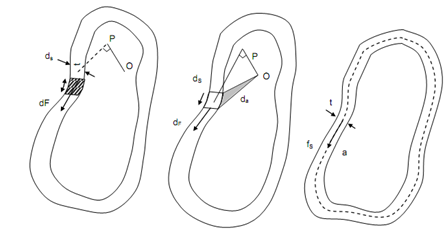Derive a relation between the torque and shear flow:
We shall now derive a relation between the torque T applied to a hollow member and the shear flow q in its wall. We let a small element of the wall section of length ds illustrated in Figure (a). The area of the elements dA = ds t and the magnitude of the shearing force dF exerted on the element is
dF = τ dA = τ t ds = q ds
The moment dM0 of this force about an arbitrary point o within the cavity of the member may be obtained by multiplying dF by the perpendicular distance p from o to the line of action of dF (Figure (b)).

(a) (b) (c)
Figure
We have
dM 0 = p dF = p (q ds) = q ( p ds)
But the product is equal to twice the area dA of the shaded triangle. Therefore, we get
dM 0 = q 2dA
Integrating
∫ dM0 = ∫ q (2 dA)
Here, ∫ dM0 represents the sum of the moments of all the elementary shearing forces exerted in the wall section, and since this addition is equal to the torque T applied to the hollow member,
T = ∫ dM 0 = ∫ q (2 dA)
T = 2 qA
where, A is the area bounded by the centre line of the wall cross-section.